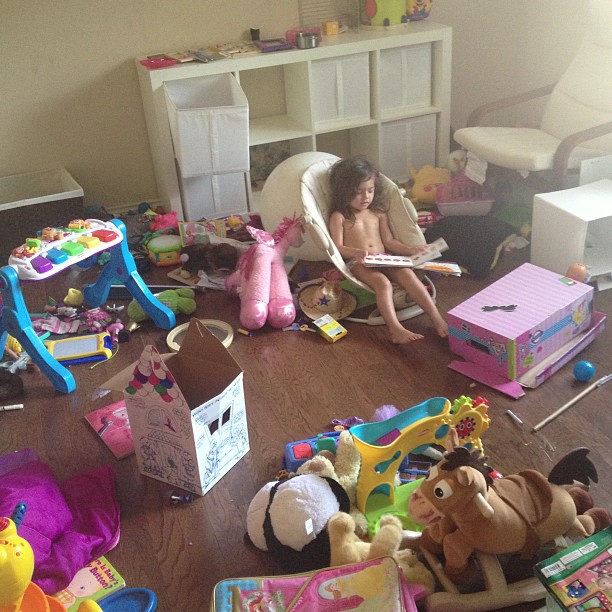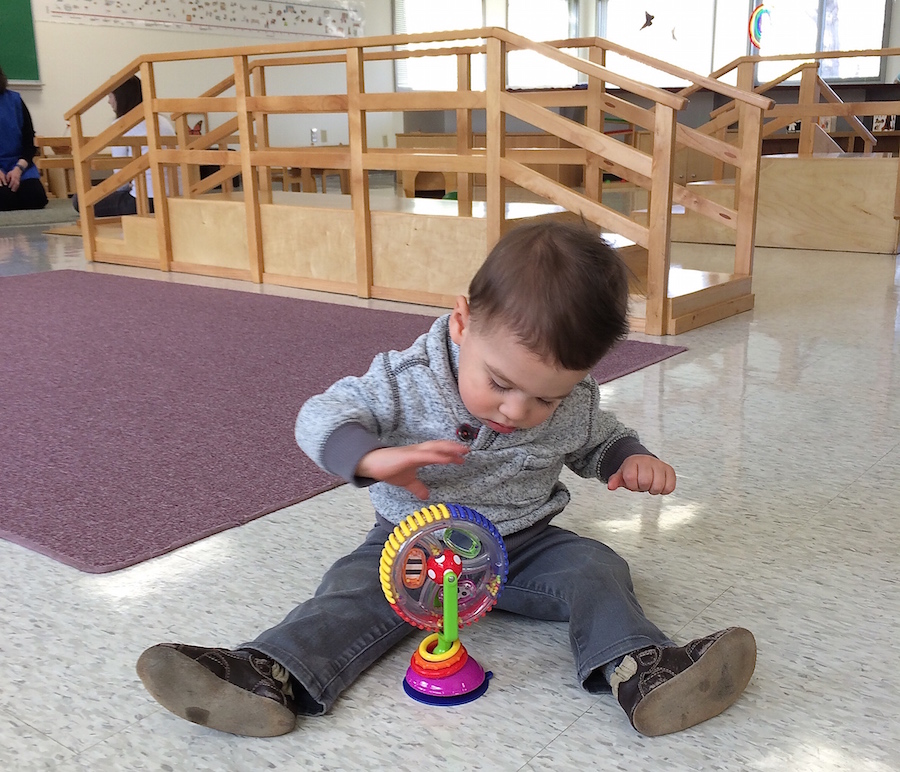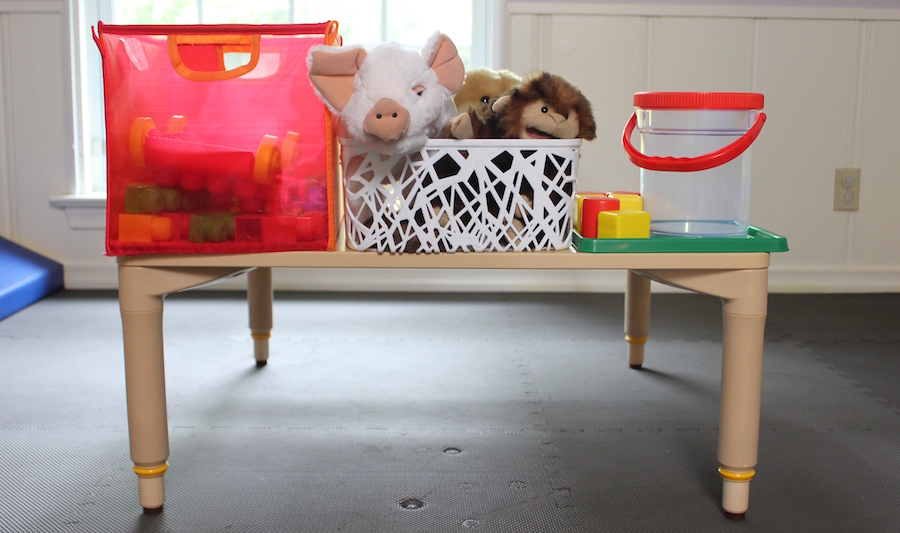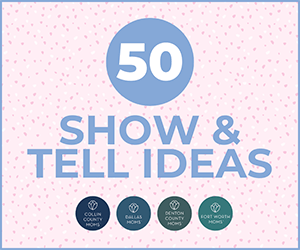Recently I shared why I got rid of my wardrobe. But long before I tackled my closet, I took on the toys. I vowed there would be no more stepping on Legos in the middle of the night and tripping over blocks. Too many toys are a safety hazard and a sanity hazard.
I have to argue that any child would be completely overwhelmed with a selection of toys as lengthy as the Cheesecake Factory Menu. Just like I felt about my wardrobe, I believe maintaining a short “fine-dining” menu of higher quality, carefully chosen toys is a better fit for children.

So I knew what I didn’t want: toy chaos. What I did want was a tranquil space for my son to play independently. After all, we know kids learn through play. So I pictured his playroom to be like his office. The place were the real work (a.k.a playing) gets done.
We started to learn about a child’s “work” when we enrolled Nicolas in a playgroup in our neighborhood. It was at a Montessori school–which we didn’t know a thing about. The first week, my husband David took him to the group. David came back from the group with an excited but confused mix of feelings. He explained to me that the classroom felt empty–maybe even a little boring.
David told me everything in the classroom had its place. Each toy in the classroom had its own little basket and a special spot on the shelf. And the rule was that each child should only play with one toy at a time, and put it away when they are done. Groundbreaking, right? What’s more, he said that all of the kids were completely engaged in the few toys the room had to offer. There was no mischief-making…no one trying to unload the teacher’s cupboards, bite their friends, or run out of the room. I was intrigued.

The following week I observed it myself for the first time. After my first observation, I was sure that the school was lacing the Kool-Aid with a special rule-following medication. Either that or it was a cult. I couldn’t get over how well the children played independently. They were completely absorbed and occupied in their tasks at hand. I was determined to figure out what the secret was so I could jump on the bandwagon and bring it home.
I started to read a little more on the school’s philosophy behind their seemingly minimalist classrooms. I quickly came across a blog post entitled “There’s just too much stuff.” It resonated with me because, like most of America, we.just.have.too.much.stuff. I found out the answer to my problem was having fewer toys, and picking the right toys. To quote the author:
The things we surround ourselves with are not always lovely, not always useful or meaningful. In our house, we have closets and a garage full of things we don’t really need or use. We have living spaces that are cluttered with toys, books, games, art projects and the like. Often these things have missing or broken pieces…What I will do is be more deliberate about what we really need, what is truly engaging, and what is lovely and pleasing to us. I intend to be more thoughtful in how these things are arranged, displayed and organized. Nothing is stacked or hidden, nothing is in a toy box or in cluttered bins. The children can see the materials, can access them easily, and can put them away with ease.
And with that quote, I was sold. Hook, line, and sinker.

We created our son’s office playroom in a way that we hope he will be learning and playing in for years to come. Is it extreme? Yes, absolutely. But we have already seen how wonderful it has been for his play, development, and sanity (heck, mostly our sanity). Here’s how we did it.
1. We started with a completely bare space. Starting with an empty play room allowed us to add each item in one-by-one with careful consideration.
2. We got the right organizers. Toy boxes and large bins are a bottomless pit that invite dumping. Instead, we have trays and short (6 inches) containers that can easily be accessed without mess making. These types of storage containers ensure that the items are easy to see, easy to access, and contained.


3. We found a toy-style. Just like people have different clothing styles, there are also different toy styles. This grandma’s toy-style really stuck with me.
Several years ago, I was trying to find a hobbyhorse, the kind that has a horse’s head on a stick, for my youngest granddaughter who had fallen in love with all things horsey. Much to my surprise, I could never find one that didn’t make all sorts of horse sounds and play cowboy songs — we quickly removed the batteries. A silent horse allowed her to create her own sounds and stories.
Our toy-style includes mostly toys that are task-based (a shape sorter, a puzzle—generally toys that you can “complete” or master). We also try to incorporate many open-ended toys, much like the silent horse.

Although it may be controversial, we request “no gifts” at birthday parties. Our close family and friends spend time with him and are familiar with our toy-style. They tend to purchase great additions to his space. If we do receive a gift thats not “our style”, we try to repurpose it or donate it to a good cause. If someone gifted me some jeans that were clearly too small or weren’t my style, it is unlikely to would wear them. I don’t think the use of toys should be much different.
4. We changed how we buy toys. Rather than sticking to the birthdays and holidays to buy toys, I buy them year around. We have a “one-in-one out” policy, with 15 toys and 8 books in the playroom at any given time. I buy toys used as much as possible. And when he outgrows them, I put them into storage for our future children.
I don’t get sucked in to things that “look super fun”. I buy toys all year to meet his developmental needs and interests-which are always changing. Once he masters the chunky shape puzzles, it’s time to move onto the jigsaw. Keeping the toys appropriate for his current age keeps him engaged. If the room was filled with toys that were too baby-ish or too mature, he would either ignore them or play with them inappropriately.
5. We keep variety. I always make sure to keep at least one of each of following types of toys: Gross motor, fine motor, plush, stacking, building, connecting, puzzles, pretend play, musical play, art play, and of course books–the books are rotated regularly.
6. We keep it minimal. I rarely put out an entire set of anything. Does he really need access to all 300 Mega Blocks that came in the set? No. Usually 50 will do the job. And he only needs one Thomas the Tank Engine. He does not need Birthday Thomas, Musical Thomas, Light-up Thomas, AND Halloween Thomas. Setting boundaries helps to free up space in the room and makes for easy clean up.
Speaking of clean up…it’s so easy. If I do it myself after bedtime it takes me 1 minute and 20 seconds (yes, I timed it) to put everything back in perfect working order. If Nicolas helps, it obviously takes a bit longer. It’s not always clean. And he doesn’t always (or even usually) put away the toys as he plays. But I feel good about where we are at right now.

I don’t want to spend the next decade yelling at my kids to clean up their toys. If the toys are manageable they will not only be easier to clean up, but easier to get out and enjoy.
And he does enjoy them. Nicolas is an incredibly happy, busy little man. I feel confident that these toys provide him with a lot of fun and numerous opportunities of exploration and creativity.
What do you think of our toy philosophy? I know it will get challenging as he gets older. And even more challenging as we think about adding more children to our family.
Do you think you could make something similar work in your house?
This Dallas Moms Blog original post was featured on August 13, 2015 by The Today Show. We’re proud of our website and the amazing expertise all of our contributors bring to this collaborative website! You can see the video here:
[xyz-ihs snippet=”Today-Show–Rid-of-Toys”]














I’m currently working in this strategy in our house… Glad I’m not the only one
Such a fantastic idea!
Already thinking how we can do this in our home.
I’m not so sure I entirely agree with your approach. I think it sounds a little bit limiting. You say you put away toys that aren’t for his age group because he will play with them ‘inappropriately’. Is there really any inappropriate way to play? Surely it allows him to explore an item in many different ways at different stages and allows development of creativity. If he can’t use all 300 mega blocks at once, how can he build ‘the whole world’ the way my son does, incorporating a whole range of different toys and household objects. Lord knows they’ll have to follow ‘the rules’ soon enough. Why dim their spark prematurely?
I believe she explained it something like this-if he has mastered peg puzzles, she puts them away and gets him jigsaw puzzled. I have a toddler and several tweens, and I see this as a good thing for their development. I understand what you’re saying about not being over-limiting, but she is referring to an 18 month old toddler not needing 300 Megabloks. That’s a lot for him to learn to manage and care for and put away. Sure, when he’s older, he might enjoy and be willing to care for hundreds or thousands of Lego. I learned this the hard way when I got a huge set of 500 wooden blocks for my children. They had fun, and it took a while to clean up, but they did it. Seeing how they played with them every day, we got ANOTHER set of 500. Can you imagine putting 1,000 blocks away? They stopped playing with the blocks at all because cleaning them up became an ordeal! So we pared down the blocks to the cream of the crop, and now they are creating with them again. We have learned this over and over. We have 2 containers of amazing Magnatiles. The older ones will only get one out at a time because it’s enough and is manageable. Too many toys is overwhelming-especially for toddlers. But yes, let them create the whole world with what they have. They will!
He was 18 months old at the time. As he ages, he’ll want more.
I have kids of multiple ages, so I never pare down any of the categories like this. Would work fine for one, though.
This Is perfect. I have been thinking this same thing for months and just didn’t know where to start. Thank you so much for giving me the jumpstart!
I love this idea. I’m all about encouraging kids imagination. I have started telling people not to get my 2 yr old things with batteries, or to take them out prior to giving them to her. I like the idea of not having as much, and I’m sure she would too. We have a play room that is pretty minimal, but in the living room, we have a toy chest that is full. On more than one occasion, she has looked in the toy chest, looked at me and/or her dad and said, “too much stuff”. Lol. We promised her we would donate some of her toys to a charity. That made her happy.
I never thought to request no toys for birthdays and such. I should just tell everyone no presents at all unless it’s a book because her grandma tends to buy her TOO MUCH CLOTHES!!!! It drives me nuts. She doesn’t even wear half of the stuff she has and often grows out of it before she can wear it. O.o.
I don’t know if you covered this in one of the above comments – but here’s my problem: I LOVE to purge! Your pictures are my DREAM! However, we have 7 right now, from 1yr – 12 yrs. The older ones keep their toys in their room, just a few at this point in their lives – and the youngers are in two separate play areas. But what about GRANDPARENTS?? They don’t necessarily understand what I’d like to do with toys and they buy things (like that pair of jeans that is too small) that are often tacky and I want to get rid of that very hour – so how do I do it without hurting their feelings? Any suggestions?
Love this article, thank you! Some really thought provoking ideas.
From nursery needs through to birthday present suggestions I’ve been trying to keep ‘stuff’ to a minimum as we have a small house and from an excessive consumerist and environmental POV (picturing all the plastic junk toys at the tip fills me with horror!) but this approach has really piqued my interest further in how it can benefit development.
Is there a book /blog or some other reference that gives an overview of the Montessori principles you would recommend?
Great ideas! We’ve told family not to buy any toys that make noise, and we weed out any that do. We also try to keep only sets of toys (big lego, trains, playmobil, blocks, cars), and not a huge assortment of different things. We keep the toys in bins in the crawlspace and bring out the one they want to play with for a few days at a time. My problem is dealing with more than one bin being out at a time, because they’re so creative they like to use multiple sets at a time, like lego to support elevated train tracks or blocks to build houses for their cars. Then they have a bigger mess to clean up and they’re a lot more reluctant to clean. But at the same time, I don’t want to limit their creative play. I like to see them using things for other purposes than they were meant for, to think outside the box to solve problems and use things in new ways. That is my dilemma.
I’ve been increasingly embracing minimalism overt the past couple of years, but often struggle with some of the execution. I have 4 children, all at different ages and stages, and each with quite different interests. A lot of our family live further away and like to send gifts for birthdays etc, partially because they can’t spend the quantity of time they would like to with our children. They don’t want to give money or pay for swimming lessons. How do you work with your family and friends, still allowing them to express love through giving and receiving, while also stemming the inflow of “stuff”?
You can casually mention a wishlist (like wishlist.com) or set up a blog describing events and activities your children would love to do. Since your family doesn’t want to send $ for lessons and activities, you really can’t do much about that and remain gracious. If they do try it out just once, make sure the children rave to them about what a treat it is so they are likely to do it again. If they want to send gifts, you can keep items on the wishlist for things that need replacing such as a new bike or helmet or sports equipment as they are outgrown. Beyond that, just say thank you and pass things along that you don’t want in your home. It is okay to do that. When they do give a useful gift, mention it often in a pleasant way. The main thing is to be grateful and gracious and only offer a wish list to those that want it.
My husband would love this article. After reading this, I’ve definitely been motivated to clear out some toys!